What's New
Displaying results 4871 - 4880 of 4914
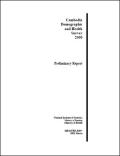
Resource | Publications,
The main objective of the CDHS 2000 was to obtain current information on demographic conditions, family planning, infant and child mortality, domestic violence, and health related information such as breastfeeding, antenatal care, child immunization, children’s diseases and HIV/AIDS. Also the questionnaires are designed to evaluate the nutritional status of mothers and children and measure the prevalence of anemia.
This report presents the preliminary findings from the CDHS 2000 that are expected to be used by policy makers to evaluate the demographic and health status of the Cambodian population in order to formulate appropriate population and health policies and programs in Cambodia. The final report of the CDHS as well as the summary report containing more detailed findings will be published in the first half of 2001.
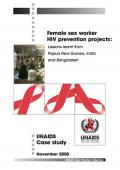
Resource | Publications,
The set of case studies in this collection emerged from a session entitled Best Practices in Female Sex Worker Projects held at the Fourth International Congress on AIDS in Asia and the Pacific in Manila, October 1997. Preparation for the session began in May 1997 when UNAIDS sponsored an effort to learn about sex worker projects in the region. Lists of known potential projects were elicited from sex work networks, well-connected individuals and researchers. A call for responses was placed on the SEA-AIDS list server.

Resource | Publications,
Faced with the increasingly devastating impact of HIV/AIDS on individual and community well-being, and on development, life expectancy and childhood mortality, many governments have been reviewing the nature of their response to HIV/AIDS. Some have raised the issue of whether the principles of confidentiality and informed consent have hindered efforts to prevent the onward transmission of HIV. Particular concern has been expressed regarding the vulnerability of women to infection by husbands or partners who do not know their status, or refuse to reveal it or refuse to practise safe sex. This has led to calls to adopt policies such as named HIV case- reporting, mandatory disclosure of status and criminalizing the deliberate transmission of HIV.

Resource | Publications,
This document shows the HIV/AIDS cases in Indonesia thru October 2000 based on the Directorate General CDC and EH Ministry of Health, Republic of Indonesia.
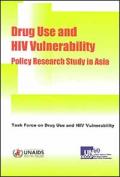
Resource | Publications,
Effective prevention programmes have reduced HIV risk and lowered or stabilised HIV transmission rates in some countries of Asia. At the same time, however, warning flags have been raised after information from new data collection efforts have revealed that injecting drug use is spreading and that condom use is uncommon, including among clients of sex workers and men who have sex with men. In many places prevention efforts are hampered by the shame and stigma attached to AIDS.
Drug use and HIV vulnerability remain issues of great concern for many countries in Asia and the Pacific because surveys indicate that in some geographical areas more than sixty per cent of all injecting drug users are HIV- positive. In several Asian countries, injecting drug users represent the largest group of those who are HIV-positive.

Resource | Publications,
This document shows the HIV/AIDS cases in Indonesia thru July 2000 based on the Directorate General CDC and EH Ministry of Health, Republic of Indonesia.
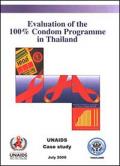
Resource | Publications,
From the earliest days, many Thai public health workers and researchers had feared that widespread sex work would come to dominate the Thai epidemic, a viewpoint strongly validated by the available data from the early 1990s. Thus, even as early as 1989, a new approach to promoting condom use in commercial sex was being pioneered in Ratchaburi province: the 100% Condom Programme.
The programme addressed the observation that sex work establishments requiring condom use or sex workers insisting on condom use would often lose clients and money to those who did not. Because many clients did not want to use condoms, there were economic disincentives for establishment owners who promoted safer behaviour at their establishments: men could simply go to another establishment or to a sex worker who did not require condoms. Regional Communicable Disease Control officials in Ratchaburi in 1989 realized that one solution to this fundamentally economic problem was to require that all establishments and sex workers in the province use condoms in every sex act.
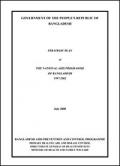
Resource | Publications,
This Strategic Plan provides a framework for a national response to AIDS and defines Bangladesh's strategies and priorities for STD/AIDS prevention and care for the next five years (1997-2002) in line with National Policy. The plan builds on work already done and emphasizes a multi-sectoral response to the AIDS problem to include enhancing the involvement of various Governmental Ministries, NGOs, the private sector and the community; and outlines programme management aspects including monitoring and evaluation. This strategic plan also provides a guide for further planning and for the development of sector-specific work plans, which will follow.
The broad strategies and interventions included in this strategic plan take into consideration the present epidemiological situation and the likely future scenario.
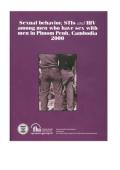
Resource | Publications,
In June 2000, FHI undertook a cross-sectional survey of men who have sex with other men. The objectives of this study were to assess the prevalence of HIV, syphilis and other sexually transmitted infections (STIs), and risk behaviors among men who have sex with men (MSM) in Phnom Penh (PNP), Cambodia. The survey was conducted at selected locations, as defined by an extensive mapping exercise.

Resource | Publications,
This publication is based on the experience of the authors and of other researchers and programme developers with various migrant populations in Israel in HIV/AIDS prevention and the related fields of sexual health and sex education. Examples are drawn from the work with two recent waves of immigration from Ethiopia and the former USSR to Israel. Observations were made on similarities between the migrant populations as well as on their unique characteristics in inter- action with a host culture. This resulted in developing culturally sensitive HIV/AIDS prevention programmes while responding to the general needs of the migrant populations.





